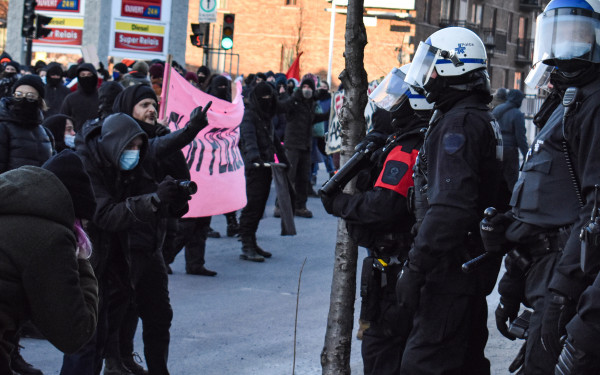Montrealers protest three deaths at the hands of Quebec police
The crowd called for justice for victims, less policing and lasting positive change
On April 6, protesters gathered at the intersection of St Hubert St. and De Maisonneuve Blvd. E. in Montreal to demand justice following the deaths of several people after recent police interventions.
The march began at 6 p.m., and the crowd made their way to Mont-Royal Metro station, chanting victims’ names and demanding justice for them. Some held signs calling out police brutality, while others chanted slogans of a similar nature.
The gathering was mainly organized in response to the two deaths that occurred at the end of March within 12 hours of one another, directly following police intervention in Montreal. One of the victims was shot in Hochelaga-Maisonneuve. Both deaths are now under investigation by the Bureau des enquêtes indépendantes (BEI), Quebec’s police oversight commission.
However, for many at the April 6 demonstration, this investigation is not sufficient.
Alexandre Popovic, one of the night’s speakers, addressed the crowd, saying he had 13 reasons to show up that day. He then began listing 13 recent victims of Quebec police, finishing his list with 29-year-old Abisay Cruz, the most recent victim killed in Saint-Michel following a police physical altercation.
Popovic also revisited the story of Koray Kevin Celik, a Concordia University biochemistry student who, in 2017, under the influence of alcohol and prescribed medication, intended to get in his car and drive. Celik’s family called 911, but by the time the police got there, he had reportedly calmed down and was sitting on his bed.
However, following an altercation in his bedroom in which police attempted to subdue Celik with force, Celik experienced cardiac arrest and was later pronounced dead in the hospital. The officers involved in this incident were never charged.
“I’ve spent years supporting the families of people who’ve died at the hands of police, including the Celik family,” Popovic told the crowd. “It’s important to speak out, to denounce what’s happening, to mobilize. Otherwise, the victims get forgotten. That’s the problem. Mainstream media copy and paste whatever the BEI puts out.”
Also in the crowd was Sandra Cordeiro, a mother who said she felt compelled to attend out of empathy for the families of the victims. Earlier that afternoon, she said she had attended the vigil for this same cause in Saint-Léonard.
“Earlier today, tear gas was thrown at us,” Cordeiro said, “and look here, too many police officers all on horses and bikes. I don’t understand why. People are here to mourn the deaths.”
Ted Rutland, associate professor in the department of geography, planning and environment at Concordia, was one of the speakers during the demonstration. He directly addressed the crowd, stating that the problem was not merely about poor policing; it was more fundamental and structural in nature.
“Police were not instituted to protect people,” Rutland said. “They were created to control and dispossess. It has nothing to do with safety at all.”
Rutland pointed to the structure of policing as the root of the problem.
“Officers have de-escalation training. Anti-racism workshops exist. And yet, the murders continue,” Rutland said. “You can’t reform something that was never designed to protect us.”
Rutland added that approximately 75 per cent of all 911 calls pertain to emotional, rather than violent, distress.
“The answer to this problem should not be more police,” Rutland said. “Fewer police is the answer.”
As the group neared Mont-Royal station at around 8:30 p.m., the crowd remained active in its chants and calls for justice. No injuries or arrests were reported, according to the SPVM.


_600_832_s.png)




